
On Earth, gravity and acceleration are fundamental cues that help humans orient themselves and determine how far they’ve traveled. However, in the unique environment of space, these cues are absent or altered, challenging astronauts’ ability to navigate and move effectively.
Recent research, published March 13 in Nature’s npj Microgravity, explores how the human body adjusts to a microgravity environment, such as that experienced on the International Space Station (ISS). The study, carried out by researchers from York University in collaboration with NASA and the Canadian Space Agency, reveals that despite the lack of traditional gravitational cues, astronauts maintain a surprisingly robust ability to estimate distances traveled based on visual cues alone.
These findings are a small but key step toward ensuring astronaut safety and operational efficiency in space — and they may even offer insights into managing age-related balance issues on Earth.
Does weightlessness affect spatial awareness?
When aboard the ISS, orbiting some 250 miles (400 kilometers) above Earth’s surface, astronauts live and work in a state of continuous free-fall, creating what is known as a microgravity environment. This unique setting provides researchers with a rare opportunity to study human perceptions under conditions that are unattainable on Earth.
“It has been repeatedly shown that the perception of gravity influences perceptual skill,” said Laurence Harris, a vision and motion perception expert at York University, in a press release. “The most profound way of looking at the influence of gravity is to take it away, which is why we took our research into space.”
“People have previously anecdotally reported that they felt they were moving faster or further than they really were in space, so this provided some motivation to actually record this,” Harris said.
Harris’s curiosity led to a comprehensive study involving 12 astronauts — six men and six women — who carried out spatial tests using a virtual reality (VR) headset before, during, and after their time aboard the ISS. The researchers found that despite not feeling the familiar force of gravity, astronauts largely maintained their ability to sense how far they traveled.
Astronauts can still accurately judge distance traveled
“Based on our findings,” Harris said, “it seems as though humans are surprisingly able to compensate adequately for the lack of an Earth-normal environment using vision.”
The implications of these findings extend beyond academic interest. They directly impact the safety and operational capabilities of space crews. The ability to judge distances accurately in an environment where typical cues are absent is vital for avoiding hazards and quickly responding to emergencies.
“On a number of occasions during our experiment, the ISS had to perform evasive maneuvers,” said Harris. “Astronauts need to be able to go to safe places or escape hatches on the ISS quickly and efficiently in an emergency. So, it was very reassuring to find that they were actually able to do this quite precisely.”
Due to the packed schedules that the astronauts faced when arriving on the ISS, the study did not test the astronauts during the first few days of their flights. However, Harris said, “it’s still a good news message because it says that whatever adaptation happens, happens very quickly.”

Implications on aging and balance
In their study, the researchers also briefly discuss the possible terrestrial implications of their space-based findings, particularly related to aging and balance. Because the study indicates astronauts can adequately estimate self-motion, it suggests that balance problems associated with old age may not be related to the vestibular system.
“It suggests that the mechanism for the perception of movement in older people should be relatively unaffected,” said Harris, “and that the issues involved in falling may not be so much in terms of the perception of how far they’ve moved, but perhaps more to do with how they’re able to convert that into a balance reflex.”
Although much more research is still needed on the topic, this study does hint at potential new avenues for developing treatments and preventions for balance disorders among the elderly, who are increasingly at risk of falls as global populations age.
The importance of space health research
This investigation marks the first of a series of three studies aimed at understanding the range of perceptual changes astronauts experience when living in a microgravity environment. Future research will explore how microgravity influences other perceptual abilities, such as estimating body orientation and object sizes.
“We’ve had a steady presence for close to a quarter century in space,” said Harris, “and with space efforts only increasing as we plan to go back to the Moon and beyond, answering health-and-safety questions only becomes more important.









